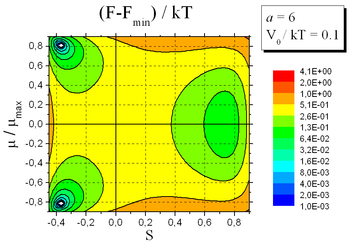Directional Deformations in Photosensitive Azopolymers
Collaborators:
Nikolai Liumbitsev, Dmytri Ryndyk, Vladimir Toshchevikov and Olga Guskova

Introduction
Azobenzene polymers have been extensively explored in the last decade as photo-deformable smart materials. They have a number of technical applications as data storage media, aligning layers in display and semiconductor technology, light-controllable artificial muscles, etc. We develop a theory of light-induced deformation of azobenzene polymers both for glassy polymers and for crosslinked azobenzene elastomers. The reorientation of azo-chromophores perpendicular to the polarization of light is found to be a self-sufficient explanation for the photo-mechanics of azo-polymers. The theory demonstrates that the light-induced stress caused by azo-reorientation is enough to deform glassy polymers irreversibly and the sign of deformation (expansion/contraction) depends on the chemical structure of the molecules. The results of the theory are in agreement with molecular dynamic simulations performed by us to study light-induced deformation of azobenzene polymers with different chemical architecture. Presently we study the effects of orientation interactions between chromophores on the light-induced deformation and the kinetics of this deformation.
Cooperation:
Influence of Liquid-Crystalline Interactions

We investigate light-induced deformation of azobenzene elastomers which can display liquid-crystalline (LC) order. It is shown that photo-mechanical behavior of azobenzene elastomers is determined by the strength of the LC-interactions which is proportional to the density of rod-like azobenzene chromophores. At weak LC-interactions, a uniaxial order and uniaxial deformation of azobenzene elastomers along the polarization vector of the light E is observed. At strong LC-interactions, the light is able to induce a phase transition from the uniaxial to the biaxial state, with two axes being related to the vector E and to a preferable alignment of the chromophores in the plane perpendicular to E. The phase transition can be either of the first or of the second order. Azobenzene elastomers can demonstrate elongation or contraction along the polarization vector E, depending on the orientation distribution of chromophores around the main chains of network strands. The results of the theory are in a qualitative agreement with experiments and computer simulations, which demonstrate biaxial ordering in azo-containing polymers.
Computer Simulations of Microstructure

We carry out molecular dynamic simulations of photo-mechanics in glassy azo-oligomers and cross-linked azo-elastomers. We use a semi-atomistic model, in which hydro-carbon groups are represented as Lennard-Jones spheres and azobenzenes as Gay-Berne ellipsoidal particles. In accordance with the theory, a sample can either expand or contract along the polarization direction E depending on the chemical structure of macromolecules. Angular distributions of chromophores in respect to the backbones obtained at different temperatures serve as input into a theoretical expression for the striction stress, which was found to be positive for the structure under investigation. The light-induced reorientation of typical propeller-like structures is shown to be a microscopic reason of the sample elongation. The azo-propellers work as nanoscopic actuators which convert the light energy into material deformation. This finding opens a way for prediction of photomechanical properties of azo-compounds directly from their chemical structure. We plan to increase a predictive strength of our approach by extracting molecular conformations of azo-compounds from atomistic simulations.
Highlights:
- S. Loebner, B. Yadav, N. Lomadze, N. Tverdokhleb, H. Donner, M. Saphiannikova, S. Santer
Local direction of opto-mechanical stress in azobenzene containing polymers during surface relief grating formation
Macromolecular Materials and Engineering, accepted - M. Koch, M. Saphiannikova, O. Guskova
Cyclic photoisomerization of azobenzene in atomistic simulations: Modeling the effect of light on columnar aggregates of azo stars
Molecules 26 (2021) 7674 - B. Yadav, J. Domurath, K. Kim, S. Lee, M. Saphiannikova
Orientation approach to directional photodeformations in glassy side-chain azopolymers
J. Phys. Chem. B 123 (2019) 3337–3347 - M. Montagna, O. Guskova
Photosensitive cationic azobenzene surfactants: Thermodynamics of hydration and the complex formation with poly(methacyrylic acid)
Langmuir 35 (2018) 311–321 - V. Toshchevikov, T. Petrova, M. Saphiannikova
Kinetics of ordering and deformation in photosensitive azobenzene lc networks
Polymers 10 (2018) 531 - V. Toshchevikov, J. Ilnytskyi, M. Saphiannikova
Photoisomerization kinetics and mechanical stress in azobenzene-containing materials
Journal of Physical Chemistry Letters 8 (2017) 1094-1098

